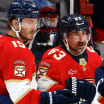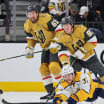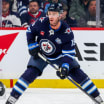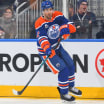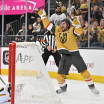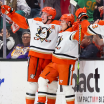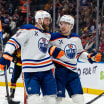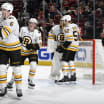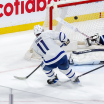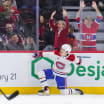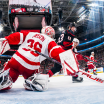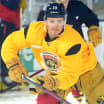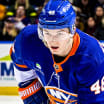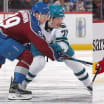For MacInnis, it was a sheet of plywood on the side of his dad’s barn, as he fired the bounty of pucks he had collected over the glass -- or rather, chicken wire -- at the rink that his father managed.
“You needed things to do during the summer,” MacInnis said. “I would fire pucks all summer long. It was just something we did as a pastime. Obviously, we always had a dream that someday we might play in the NHL, but never thought that would ever come through.
“I did it all the time. You’d get bored being at the beach or bored riding the bikes so long and I would just shoot pucks. That’s where I started to develop the shot.”
It would be that rare one, one out of every 20 or 25 or so, that would ring off the stick and would take him aback.
That, he would think, was hard.
“But when you think back, you realize that there’s a lot more that goes into it, but you don’t think of it at the time,” MacInnis said. “Transferring your weight is a big part of it. Core strength is a huge part of it. The stick itself, for me, the shaft would have to be the right flex.”
* * * *
The stick. Ah, the stick.
MacInnis was devoted to the wooden stick. Chara believed that once he transitioned to composite, that made all the difference. Chara used a 155-flex stick that could boggle the mind with its stiffness. Frk uses a 70 flex.
There is no one path to a slap shot.
“The key elements that must work together involve the ability of the player to manipulate their arms, wrist, legs, feet, and the body weight, along with the extent to which the stick is bent and its timing before it hits the puck,” Bansil wrote. “More a given stick is bent, the faster the speed with which it will snap back. Greater the flex number of the stick, larger the potential energy it can store for a given amount of bending.
“Synchronizing of all these elements obviously requires great skill, much like a conductor in a symphony orchestra.”
Which is why each slap shot might just be a little bit different.
“My sticks, because they flex so much, I try to lean with my body into it,” Frk said. “That gives me more power behind because then the stick will do the job because the flex is obviously so low. So hopefully the stick doesn’t break when I’m taking the shot. If it doesn’t break, then yeah I can definitely produce a lot of power because I’m able to lean on my full body.”
Vancouver Canucks forward Elias Pettersson, meanwhile, uses 87 regularly, but has gone as high as 102.
“I know when I’ve gotten stronger in recent years, I had to go up in flex because I want my stick to be fast,” Pettersson said. “I don’t want it to be like a long flex up, like a whip. I want to the whip to be fast, like very quick, responsive. Stiffer.”
For Chara, the stick made all the difference. It was when Chara came from his native Slovakia to the Western Hockey League in 1996-97, back in MacInnis’s heyday, that the gangly 19-year-old, still playing with a wooden stick, still working on his wrist shots, found his stride. And his stick.
“We went from wood sticks to composite sticks,” Chara said. “I think that’s when goalies saw the puck the first time it was coming out of their nets when I was shooting slap shots. It was crazy. It was a huge breakthrough.
“For me, having that wood stick was heavy. I could never get it stiff enough, a wood stick, it was always kind of wimpy and heavy and once I got the composite, the weight and also the stiffness, oh my gosh, I was scoring from almost red lines.
“The puck was just invisible for [goalies]. … They were playing the puck like it was just in front of them and it was already in the net.”
MacInnis found the opposite.
“When composite sticks first came out, I tried them, but I absolutely didn’t like them at all,” he said. “I found with my shot the torque from the wooden blade gave it that extra zip, that extra few miles an hour, because there was torque and movement in the blade and it came from both the blade and the shaft.
“If you take a composite stick today, it all comes from the shaft. Those blades, you cannot move those blades. They’re like concrete.”
* * * *
Chara is 6-foot-9, 250 pounds. Weber is 6-4, 230 pounds. Pettersson is 6-2, 176 pounds.
So, sure, size matters. But it’s not everything.
“They’re usually tall, pretty muscular. Usually it’s a defenseman,” Haché said. “But then you’ll see other, smaller players who can shoot very fast. They have very good technique.”
In 2023, Pettersson took the Hardest Shot crown, recording a 103.2 mph bomb, matching the 103.2 mph shot that won Tampa Bay Lightning defenseman Victor Hedman the crown the year prior.
Pettersson had started to drill down on his slap shot after he was selected at No. 5 by the Vancouver Canucks in the 2017 NHL Draft. He spent the next season with Vaxjo in the Swedish Hockey League, and it was there that he dialed in on his shot.
“It’s all about timing,” Pettersson said. “I never had the big muscles, so it’s all about rotation speed, moving your body weight. If you think about it like a golf swing, you want to get your momentum in and just let the club following through. That’s what I want to do. I want to clear the hips and get the stick as fast as possible, as hard as possible at the contact point.”
And it’s that technique that has allowed him to defy his size, to measure up to those who outweigh him by 50 or 60 pounds.
“The basic physics is you have a rotating body, which is the player, and it collides with a stationary puck,” Haché said. “There’s basic physics there. So, math helps. If you have a bigger object colliding with a small object, the bigger the object, the faster the small object will go. You can’t avoid that.”
But here’s the caveat: The faster the moving object goes, the faster the collision will be.
“That’s where the body strength and mass help,” he continued. “So you may have somebody who is bigger but not as fast, doesn’t have the muscle mass to accelerate to the speed that you would want to. He’s not going to shoot as hard.”


